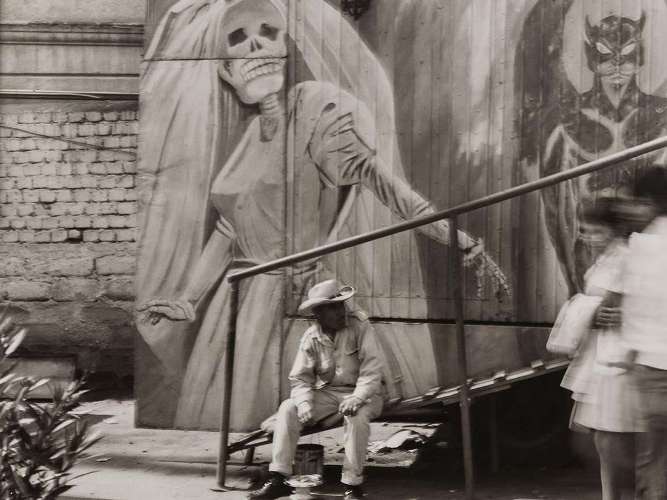
MFA Boston Acquires Group of 37 Career-Spanning Photographs by Graciela Iturbide
Boston, MA — The Museum of Fine Arts, Boston (MFA), has acquired an important group of 37 photographs by Graciela Iturbide (born 1942, Mexico City), one of the most influential photographers active in Latin America today and considered one of Mexico’s greatest living artists. The rare, vintage prints and select recent works span Iturbide’s entire career, which has focused on capturing and understanding the beauty, rituals, challenges, and contradictions of her native country. The acquisition comprises 35 photographs purchased by the Museum and two donated by the artist—all of which will be on view in Graciela Iturbide ’s Mexico, a major exhibition of her work, opening at the MFA in January 2019 and accompanied by an illustrated catalogue produced by MFA Publications.
“We are thrilled to acquire this significant group of works by renowned photographer Graciela Iturbide,” said Matthew Teitelbaum, Ann, and Graham Gund Director. “We have great conviction that her work should be seen in the context of other influential artists such as Edward Weston, Ansel Adams, Man Ray and Margaret Bourke-White. Additionally, Iturbide’s strong images will complement other recent acquisitions and displays of work which explore how cultures intersect and transcend borders.”
Iturbide’s photographs tell a visual story of Mexico since the late 1970s—a country in constant transition, defined by the coexistence of the historical and modern as a result of the culture’s rich syncretism. The acquisition represents a significant body of work by a Mexican artist, complementing the MFA’s notable collection of iconic images of the country by foreign photographers, such as Edward Weston, Paul Strand, and Tina Modotti.
Works in the acquisition range from 1969 to 2007, including many early photographs—two of which were made during Iturbide’s studies with her mentor, the modernist master photographer Manuel Álvarez Bravo. The two photographs being donated by the artist—Carro (1969) and ¡México… quiero conocerte! (1975)—reveal the hybrid cultural nature of Mexico through unexpected juxtapositions in distinct urban landscapes. The acquisition also comprises work from three projects focused on Mexico’s indigenous cultures, including: 11 images from Juchitán, an extended series that captures the essential role of women in Zapotec culture; three from Los que viven en la arena (Those Who Live in the Sand), concentrating on the Seri people living in the Sonoran Desert; and two from La Mixteca, documenting elaborate goat-slaughtering rituals in Oaxaca and serving as critical commentary on the exploitation of workers. Seven photographs express Iturbide’s interest in fiestas and their celebratory, ritualistic and theatrical environments that reflect Mexican culture. Six works represent her thematic interests in death and birds. Also included are recent photographs from Iturbide’s series featuring the Oaxaca Ethnobotanical Gardens, representing plants—mainly cacti—in intensive care, and El baño de Frida (Frida’s Bathroom), depicting personal belongings in Frida Kahlo’s bathroom at the Casa Azul, which had been locked away for 50 years after the artist’s death.
“It has been a pleasure and honor to work closely with Graciela in preparation for the exhibition and on this special acquisition,” said Kristen Gresh, Estrellita and Yousuf Karsh Curator of Photographs. “She has successfully and beautifully brought to the forefront the many untold stories of Mexico’s rich culture and history—from the eyes of an insider. We are eager to present these groundbreaking images to our global audiences—both in the upcoming Graciela Iturbide’s Mexico exhibition and in many years to come.”
Graciela Iturbide’s Mexico, opening at the MFA from January 19 and on view through May 12, 2019, will feature approximately 125 photographs spanning Iturbide’s five-decade-long career. Organized into nine sections, the exhibition will prominently feature works in this acquisition. Drawn primarily from Iturbide’s own collection, the exhibition will also display loans from museums and private collections throughout the U.S. and Mexico. The accompanying publication will feature more than 100 beautifully reproduced black-and-white photographs, alongside illuminating essays inviting readers to share in Iturbide’s personal artistic journey.
About Graciela Iturbide:
Iturbide was born in 1942 in Mexico City. In 1969, at the age of 27, she enrolled at the film school Centro de Estudios Cinematográficos at the Universidad Nacional Autónama de México to become a film director. However, she was soon drawn to the art of still photography as practiced by the Mexican modernist master Manuel Álvarez Bravo, who was teaching at the University. From 1970 to 1971 she worked as Bravo’s assistant, accompanying him on his various photographic journeys throughout Mexico. In the early half of the 1970s, Iturbide traveled widely across Latin America—in particular to Cuba and several trips to Panama. In 1978, she was commissioned by the Ethnographic Archive of the National Indigenous Institute of Mexico to photograph Mexico’s indigenous population. Iturbide decided to document and record the way of life of the Seri people, a group of fisherman living a nomadic lifestyle in the Sonoran desert in the northwest of Mexico, along the country’s border with Arizona. In 1979, she was invited by the artist Francisco Toledo to photograph the Juchitán people who form part of the Zapotec culture native to Oaxaca in southern Mexico. This series resulted in the publication of her book Juchitán de las Mujeres in 1989. Between 1980 and 2000, Iturbide was invited to work in Cuba, Germany, India, Madagascar, Hungary, France, and the U.S., producing a number of important projects.


